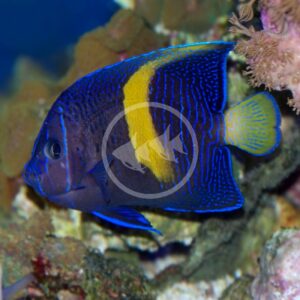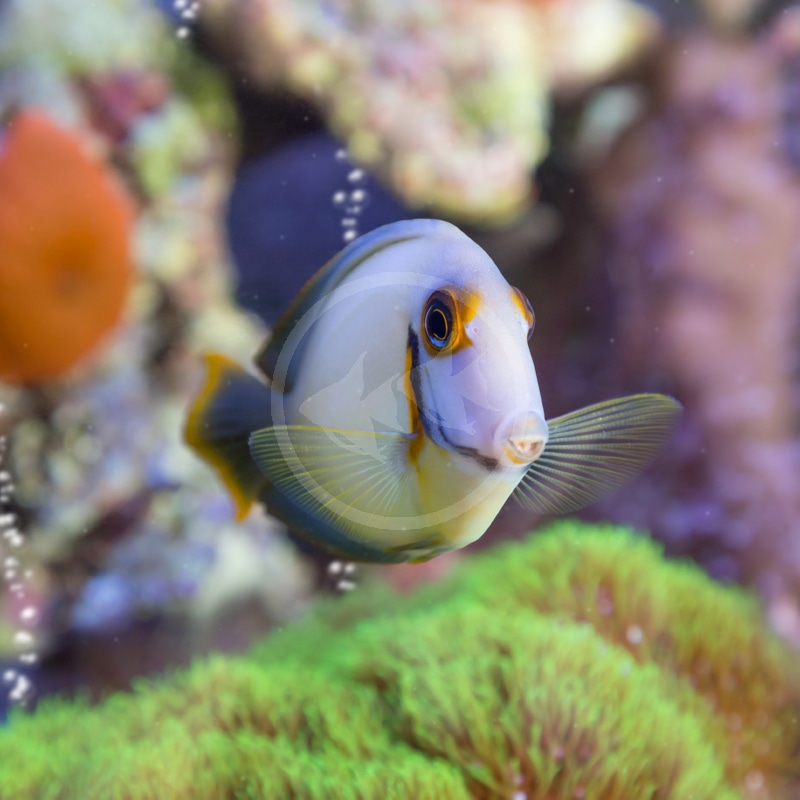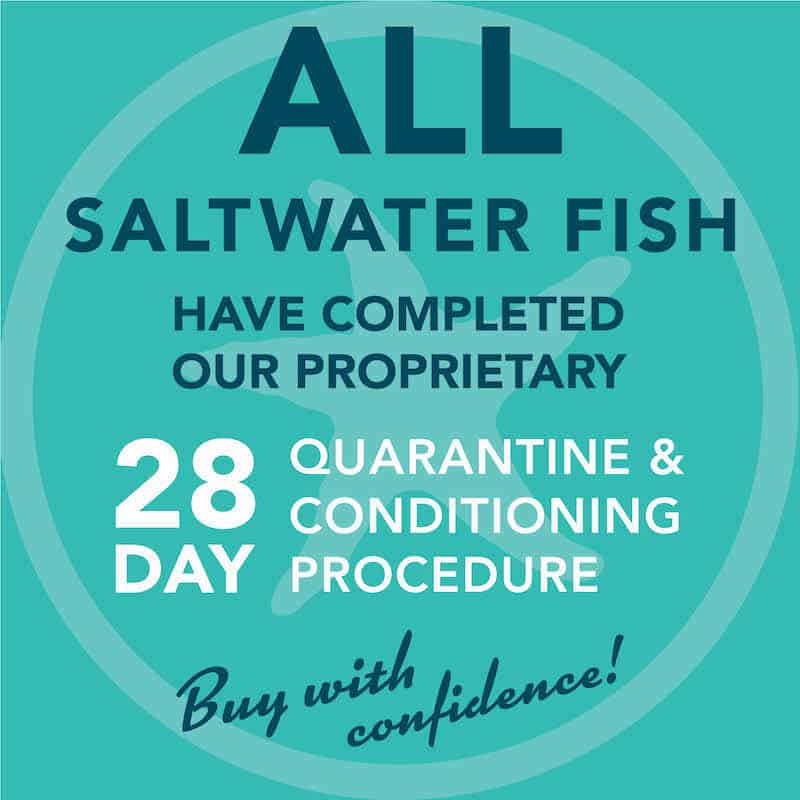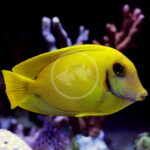
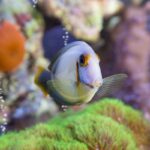

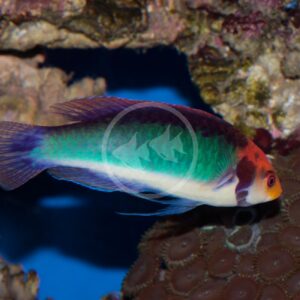
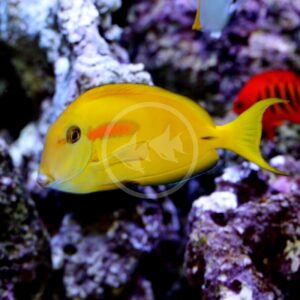
TANG – MIMIC LEMON PEEL / CHOCOLATE Acanthurus pyroferus
$169.99 – $199.99Price range: $169.99 through $199.99
The Chocolate Tang, also known as the Mimic Lemon Peel Tang or Yellow Mimic Tang, is native throughout the Indo-Pacific region. As a juvenile, the Chocolate tang takes on its pseudonym “mimic” because it resembles either the dwarf Lemonpeel Angelfish (Centropyge flavissimus) or Yellow Angelfish (Centropyge heraldi) with an overall yellow body and a blue ring around its eye if it’s mimicking the lemonpeel angelfish. As it changes into an adult, the color of its body darkens with chestnut brown hues around its eyes and all of its fins take on an olivaceous color with accents of yellow. With maturation, the tail will also become more lyre in shape. An adult Chocolate tang can reach a size of approximately 8″.
Care Level: Moderate
Temperament: Semi-Aggressive
Reef Compatible: Yes
General Description: The Chocolate Tang, also known as the Mimic Lemon Peel Tang or Yellow Mimic Tang, is native throughout the Indo-Pacific region. As a juvenile, the Chocolate tang takes on its pseudonym “mimic” because it resembles either the dwarf Lemonpeel Angelfish (Centropyge flavissimus) or Yellow Angelfish (Centropyge heraldi) with an overall yellow body and a blue ring around its eye if it’s mimicking the lemonpeel angelfish. As it changes into an adult, the color of its body darkens with chestnut brown hues around its eyes and all of its fins take on an olivaceous color with accents of yellow. With maturation, the tail will also become more lyre in shape. An adult Chocolate tang can reach a size of approximately 8″.
Diet Requirements: In the wild tangs are primarily herbivorous. A diet largely consisting of algae-based foods is absolutely necessary to maintain optimal health, coloration, immune function, and reduce aggression. If not, tangs often develop head and lateral line erosion from such deficiencies. Vegetable based flake foods or frozen foods, that may also include spirulina algae, are excellent options. We also recommend offering dried seaweed on a rock or clip three times a week minimum. Chocolate tangs will consume various other protein-based frozen foods.
Care Requirements: An established minimum 125 gallon aquarium with 18+ inch width is ideal. Smaller specimens can be temporarily raised in smaller quarters (no less than 75 gallons) as long as it is upgraded accordingly. This tang enjoys a variety of rock work to graze on and crevices to take refuge, but should also be provided with open swimming space. Chocolate tangs are often sought after to add to a reef aquarium for their natural tendency to graze upon algae build up. Typically, Chocolate tangs do not conflict with other tank-mates and aren’t overly territorial in nature. Conflict could arise from conspecifics (including other species within the genus Acanthurus). If you want to house various types of tangs together, especially other Acanthurus species, it may be best to add them all at once, or closely together at the very least, for the best success. Recommended water conditions, 72-78° F, KH 8-12, pH 8.1-8.4, salinity 1.020-1.025.
Purchase Size: Juvenile Small: 1″ to 3″; Changing Medium: 2″ to 3″; Large: 3-1/4″ to 5″; Adult Small: 2-1/4″ to 3-1/4″; Medium: 3-1/2″ to 4-1/4″; Large: 4-1/2″ to 5-1/2″
Note: Your item may not look identical to the image provided due to variation within species. Purchase sizes are approximate.
Dry goods orders are shipped via US Postal Service or UPS to the address provided at checkout based on the selection made in your website shopping cart. Product is carefully packed to help prevent any damage during shipping. Once processed you will receive a shipment notification via email with tracking number, and delivery notification. Please allow 48 hours for processing after your order is placed.
Perishable items (i.e. live plants, refrigerated/frozen foods) are shipped via US Postal Service 2-3 day to the address provided at checkout for a $25.00 flat rate charge. Items are packed with secure packing material and heat, cold, or Cryo packs as needed to maintain safe temperatures during transit. If one or more perishable items are in the shopping cart at checkout the $25.00 perishable shipping charge will automatically appear and need to be selected. Once processed you will receive a shipment notification via email with tracking number. Please allow 48 hours for processing after your order is placed.
Livestock (i.e. fish, invertebrates, coral) are shipped via UPS Overnight to the address provided at checkout for a $55.00 flat rate charge. Livestock is packed in insulated styrofoam boxes with secure packing material and heat, cold, or Cryo packs as needed to maintain safe temperatures during transit. If one or more livestock items are in the shopping cart at checkout the $55.00 livestock shipping charge will automatically appear and need to be selected. Livestock is shipped Monday through Wednesday ONLY (no weekend delivery is available) weather permitting, and we reserve the right to delay shipping until conditions are appropriate for safe arrival. Once your order is placed we will contact you to arrange the best shipping date based on these criteria. Someone must be available to receive the livestock order on the first delivery attempt. Once processed you will receive a shipment notification via email with tracking number. Please allow 48 hours for processing after your order is placed.
For mixed dry goods/perishable & livestock orders items will be shipped via their corresponding shipping methods outlined above. Dry goods will be shipped via US Postal Service or UPS based on your selection and checkout, while livestock will ship via UPS Overnight for a $55.00 flat rate charge. You will receive separate notifications and tracking numbers for the dry goods and livestock. Please note due to different carriers and shipping methods dry goods and livestock may arrive on different days.
Related products


TANG – YELLOW Zebrasoma flavescens
$174.99 – $399.99Price range: $174.99 through $399.99TANG – SAILFIN Zebrasoma veliferum
$99.99 – $199.99Price range: $99.99 through $199.99

BUTTERFLY – HENIOCHUS BLACK & WHITE Heniochus acuminata
$159.99 – $249.99Price range: $159.99 through $249.99

WRASSE – LEOPARD VERMICULATE Macropharyngodon bipartitus
$129.99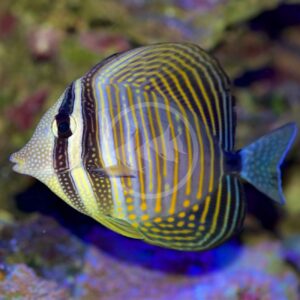

TANG – SAILFIN DESJARDINII Zebrasoma desjardinii
$169.99 – $199.99Price range: $169.99 through $199.99TRIGGER – HUMU HUMU Rhinecanthus aculeatus
$89.99 – $139.99Price range: $89.99 through $139.99

TANG – SOHAL Acanthurus sohal
$289.99 – $319.99Price range: $289.99 through $319.99